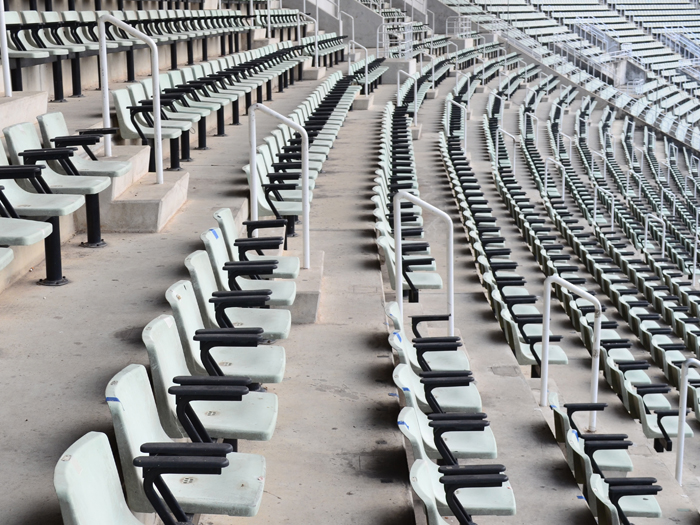3 Lessons Pro Sports Has to Offer Crowd-Driven Businesses in the Wake of COVID-19

Some businesses have been able to pivot and adapt to physical distancing measures amid the pandemic, performing services and selling products online when possible and introducing additional safety measures when it’s not.
But for industries that rely heavily on the energy of the crowd experience — concerts, festivals, conventions and professional sports to name a few — that shift hasn’t been possible, or at least, not profitable.
It’s unlikely that any event drawing hundreds or thousands of people will be allowed to take place before the development of a vaccine for COVID-19, which isn’t projected to happen until next year at the earliest.
With no clear timeline established and the possibility of waiting the virus out evaporating, these crowd-driven businesses need to think about how to execute events in the current environment if they want to survive.
Currently, pro sports leagues are feeling that pressure most, not only because fans are clamoring for a diversion that will bring a sense of normalcy back to their routines, but also because teams stand to lose millions for every game they don’t play.
The NBA averages between $1 million and $1.5 million in ticket sales per non-playoff game and is projected to lose nearly $500 million this year, including post-season games. MLB teams also generate more than $1 million per home game in sales of tickets, parking passes, concessions and merchandise. For the NFL, these sales constitute 38% of total revenue.
Watching how these leagues navigate the relaunching of their seasons — without the fans who bring in so much cash — may offer hints for other crowd-dependent businesses. Here are some three things to watch for as sports leagues consider their next steps during COVID-19.
1) How to Replace Ticket Revenue
Currently, none of the reopening plans shared by pro sports leagues address the ticket revenue shortfall.
Though some of the loss will be offset by elimination of salaries for stadium employees and lower insurance premiums that reflect reduced exposures of an empty venue, more creative solutions will have to be devised to monetize the spectating experience in other ways.
“Our sports clients are likely in a better position to do this, because while the in-person fan experience is, of course, important, our clients have other ways to bring the product to the fans,” said Marc J. Blumencranz, CPCU, managing director of BWD Sports and Entertainment, an NFP company, which builds custom insurance and risk management programs for sports organizations.
The NBA averages between $1 million and $1.5 million in ticket sales per non-playoff game and is projected to lose nearly $500 million this year, including post-season games. MLB teams also generate more than $1 million per home game in sales of tickets, parking passes, concessions and merchandise. For the NFL, these sales constitute 38% of total revenue.
Some have suggested selling digital tickets to exclusive virtual reality viewing experiences.
Digital ticketing, with tiers that allow fans access to different vantage points (i.e. do you want to watch from the nosebleeds or pay more for a seat behind home plate?) could translate well to events like concerts, plays or other performances.
For events like conferences and conventions, registration fees could likewise be tiered, with certain virtual zones, presentations or forums considered off-limits without a ticket.
2) How to Simulate Crowd Energy
The sound, bustle and collective enthusiasm of the crowd is what makes pro sports games worth attending and worth watching.
Recreating this environment is the biggest challenge facing pro leagues. Without screaming fans, will people be interested enough to keep from changing the channel?
Increasing interactive components of the game’s broadcast could potentially supplant crowd energy to keep viewers engaged.
Soliciting fan input and incorporating comments or questions submitted via social media channels can help fans feel more connected.
We’ve already seen organizations in the insurance industry deftly incorporate this interactivity as conferences went virtual.
The Vermont Captive Insurance Association’s annual conference to be held virtually this August, for example, will include chat functions that allow attendees to interact with exhibitors in the virtual exhibit hall and engage with presenters of educational sessions.
Holding virtual events in real-time, along with interactive components, can help to recreate the collegiality of a live, in-person event.
3) How to Retain Interest in Live Events
There has been some speculation that even once it is deemed safe to sell every seat in the house, teams could struggle to generate interest for a couple of reasons.
For one thing, people who lost their jobs or took pay cuts during the pandemic may struggle to afford tickets.
As the world enters into another recession, people may be more frugal when it comes to entertainment-related purchases.
There is also some fear that some fair-weather fans will simply lose interest.
Key to the longevity of any crowd-driven business will be its ability not only to offer meaningful experiences under lockdown but to also bring people back once restrictions lift, and that will depend on their ability to demonstrate that they can operate safely.
If nothing else, professional sports teams have been very detailed and clear in how they intend to keep players, staff and their families safe.
“We work to align our practices so that our office follows similar procedures as our clients,” said John Scotti, Managing Director of Team Scotti, an NFP company, an insurance brokerage dedicated to the life, accident, and health insurance needs of Major League Baseball.
“As an example, recently we wrote a COVID-19 Life and Disability Underwriting Policy and Procedure, which was approved by MLB, in order to assure that our employees follow proper protocol when games resume.”
“We know sports fans are anxious to see their favorite teams return to play in whatever format it takes, and we expect them to return to the stands and keep the teams successful over the long term,” Blumencranz said.
“Nobody would have thought it possible to have professional sporting events taking place outside of teams’ home cities without fans. We are impressed with some of the proposals that have been developing in short order while the course of the pandemic is still uncertain. Sports are important to maintaining some amount of normalcy in a strange new environment, and we are proud to be able to contribute in any way we can.” &











